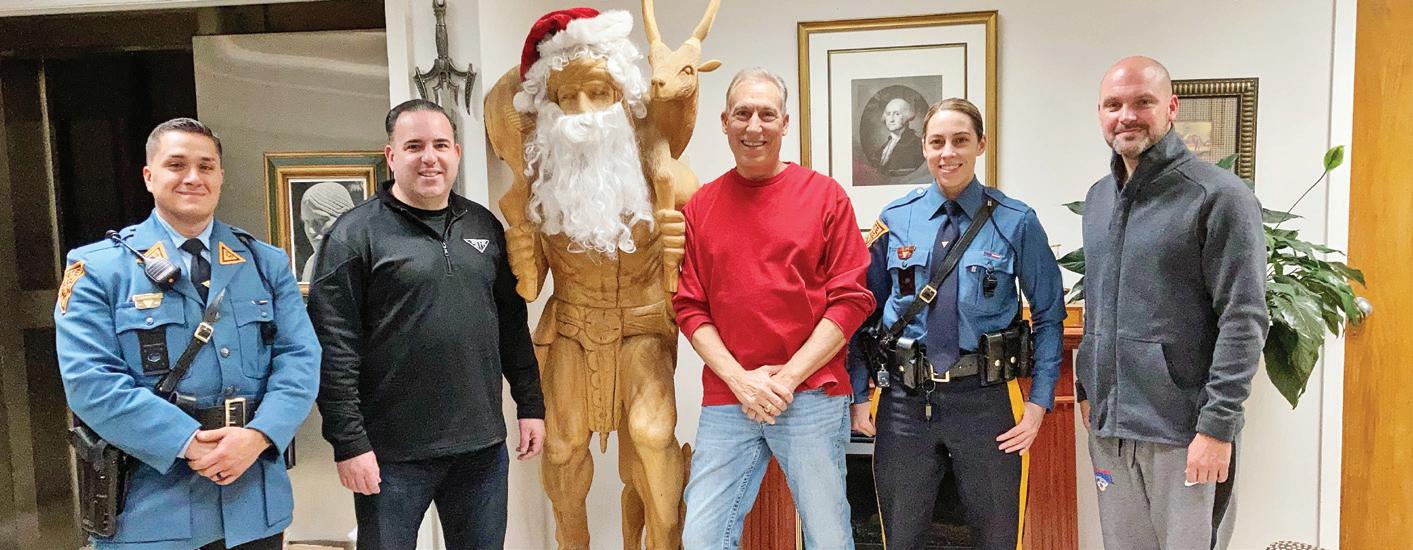
17 minute read
Worship Guide
(Continued from Page 9)

Advertisement








get from health department or the state.” (At an October 2021 township committee meeting, when a resident posed a question about when the wells at the gravel pit were last tested, Gray replied he was in receipt of a “testing report” from Oct. 11, 2021, that showed testing was performed there for a number of “volatile organic compounds,” with the results showing they were either not detected or found at rates that meet the New Jersey Department of Environmental Protection (NJDEP)’s groundwater and drinking water standards.)
John Ervin, director of development at CS Energy, the firm apparently working with the Haas family to establish a solar energy facility at the gravel pit, called the concerns expressed “very valid,” but maintained that “a lot of it will be addressed during the site plan approval process” and that the ordinance “created by the Pinelands Commission” was “not discussing a specific project.”
“I think it is a proactive move for the township to make a solar energy ordinance,” he declared. “The township will see more development like this in the future.”
Brown again reiterated “this ordinance is only addressing the zoning of the property, not the project itself.” But while William Geoghegan, who identified himself as “part of the team working on a solar project in Tabernacle,” and is a project developer at CS Energy, agreed that “this is not about approving a solar project” and “only enables a solar project to be proposed, which will be reviewed via a more intensive site plan process,” he, as the first person to speak at what was a continuation of the public hearing on the ordinance, went into a detailed explanation of the benefits of solar energy.
“According to the New Jersey Energy Master Plan, we are aiming to have 100 percent clean energy by 2050, and solar will make up 34 percent of that,” Geoghegan noted. “Every project, big or small, makes progress towards these goals and a community solar project in Tabernacle will show its commitment to a greener future.”
Community solar projects enable greater access to solar energy, he contended, and electric utility customers who have “previously been unable to go solar due to a variety of factors, can now access this




















GANG
(Continued from Page 4)
first-degree gang criminality.
The investigation into Robinson’s death revealed that GBM had a long-running dispute with certain residents of the Buckingham Park section of Willingboro, where Robinson lived.
Robinson, a Willingboro High School student who was said to be returning home from his part-time job when killed, was not involved in the conflict.
A week later, in the same section of Willingboro, a woman was hit in the leg and a toddler was grazed across his backside by shots fired into their home. Young has been charged with both shootings.
Carter and Young have also been indicted on firearms charges from a separate incident earlier this year, and Forman was charged in October 2021 with witness tampering for making multiple threatening phone calls from Burlington County Jail.
“The substantial charges we have brought against these members of the Gotti Boy Movement and their associates should make clear that we will not allow anyone to engage in indiscriminate gun violence


In-Person Services being held after Labor Day at 8:15 am | 9:30 am | 11:00 am | follow us on Facebook Live facebook.com/MedfordUMC 2 Hartford Road | Medford NJ 08055 medfordumc.org | 609/654-8111 info@medfordumc.org
renewable solar energy.”
Barton, when the ordinance was introduced on Oct. 25, 2021, noted he was also concerned about reports of possible encroachment on township property by the past mining activities, and then questioned Gray if there were any issues identified at the site, to which he replied that there had been some issues at the gravel pit cited by the NJDEP during a 2016 inspection, though Trinity Episcopal the gravel pit cleared a subsequent 2018 inspection. Barton, prior to voting against 18 C Mill St. hurch introducing the ordinance this past October, Vincentown, NJ 08088 had made a motion to have a survey done to determine whether there was actually any encroachment onto township property Worship: Sundays 10 609-859-2299 a.m. by the past mining activities. After the ordinance was introduced, the motion was entertained by the township committee, but died because it was not seconded by any of his colleagues. The ordinance ultimately passed 4-0 on Dec. 6 in Barton’s absence. The “technology, equipment, environmental impact, site design and IAmThat IAm Ministries, Inc. AllAre Welcome! Messiah L Brethren utheran Church size” are all “good questions” that “can be addressed during the site plan process,” Sunday Worship Se ervice at 11:30 a.m. Pastors Florence a and “To Know to Make JesusChristand HimKnown” Geoghegan maintained prior to that final Russell Webber r vote, focusing instead on the “tangible 50 Burrs Mill Road d, benefits community solar can have” for Tabernacle. Southampton, NJ 08088 609 -847- 4848 www.iamthatiamministriesin nc.com Pastor Todd Anderson “A community solar project presents an exciting opportunity for residents of Tabernacle to save about 20 percent on their Bible 7p St tudy .m m. 530 Virginia Drive Presidential Lakes, NJ 08015 Church (609) 893-1700 www. MessiahLBC.church monthly electricity bills by subscribing to Wednes sday Worship Service -10a.m. a project,” Geoghegan declared. “Priority will be given to low-and-moderate-income families to subscribe, and depending on the size of the project, cumulative savings could be $2.5 million over the course of the 20-year project. It will generate clean and sustainable electricity that offsets the burning of fossil fuels and will also reduce CO2 emissions.
“Additionally, passing this ordinance is a great opportunity to get the site restored in a timely fashion, where it will be consistently managed and maintained. Once the project is built and operational, it will be hardly noticeable due to the screening requirements and minimal vehicles entering or leaving the site. Given all the other potential uses, we believe solar is among the least impactful to the environment and community. We hope you agree the net positive of a community solar project will beneficially impact households in the community.” Photo Provided State Troopers join with Shamong Township Deputy Mayor Michael Di Croce (center right) to deliver toys to families in need during the holidays.
Gathering to Spread Holiday Cheer


and run roughshod over innocent people in Pemberton Township, or in any other part of Burlington County,” said Prosecutor Scott Coffina through the press release. “Yahsinn Robinson’s family should be celebrating Christmas with him right now instead of mourning him, and babies should never be exposed to gunfire coming into their homes. We are committed to doing everything we can to keep families safe throughout the county, and to bring to justice those who put our neighborhoods at risk.”
Carter, Clifton and Weathers have also been charged with “promoting organized street crime,” as has Brianna Scott, 28, of White Pine Court in Pemberton.
Scott and others are alleged to be responsible for filing multiple fraudulent Paycheck Protection Program (PPP) loan applications. The PPP is part of the Coronavirus Aid, Relief, and Economic Security Act (CARES) Act of 2020, which is designed to provide economic assistance to small businesses that suffered a financial hardship due to the pandemic.
The scam, according to both Coffina and King, yielded $124,996 in funds from PPP applications that were filed in the name of GBM members and their affiliates.
Carter, the law enforcement officials claimed, submitted an application claiming he was a barber with an annual income of more than $105,000 in 2019, even though he was incarcerated throughout 2019. He received a check for nearly $21,000, as did five of his associates, the law enforcement officials noted.
Scott was additionally charged with second-degree conspiracy to commit computer criminal activity
Others charged in connection with the PPP scam include Wanya Anderson, 25, of Jarvis Street in Pemberton, Chad Boone, 30, of Grant Street in Camden; Adam Clark, 28 of Atsion Road in Shamong; Jaquan Crawley-Pitts, 25, of Garden Street in Mount Holly; Altauron Jean, 27, of Press Avenue in Pemberton; Shalaiyha Jean, 20, of East Lakeshore Drive in Pemberton; and Zion Powe, 22, of Ashton Street in Pemberton – all of whom were charged with seconddegree computer crimes with the purpose to defraud, third-degree forgery, third-degree theft by unlawful taking and fourth-degree false swearing under oath.
Clifton and Carter were also charged with second-degree computer crimes with the purpose to defraud, and additional charges against Carter include third-degree forgery, third-degree theft by unlawful taking and fourth-degree false swearing under oath.
“This financial scheme by the defendants to obtain small business relief funds by ‘inventing’ fake businesses, phantom income and fraudulent loan applications, is merely further evidence of this group’s belief that the rules of society simply don’t apply to them,” Coffina maintained. “They are wrong, and will be held accountable.”
The cases, the prosecutor’s office said, will be prepared for presentation to a grand jury for possible indictment. The defendants will be prosecuted by Assistant Prosecutors Michael Angermeier, Jamie Hutchinson and Joseph Remy. The investigation was conducted by the Burlington County Prosecutor’s Office, with assistance from the Pemberton Township Police Department and the Willingboro Township Police Department.
The majority of the defendants were apprehended during a Dec. 16 sweep that involved the Burlington County Prosecutor’s Office, Burlington County Sheriff’s Department, Camden County Prosecutor’s Office, Mercer County Special Response Team, Mount Holly Township Police Department, New Jersey Division of Taxation – Office of Criminal Investigation, New Jersey State Police, Ocean County Special Response Team, Pemberton Borough Police Department, Pemberton Township Police Department, U.S. Marshals Service New York/New Jersey Regional Fugitive Task Force, and Westampton Township Police Department.
(Continued from Page 10)
surrounded” by farmlands, as well as “low density residential uses.”
In particular, north of the redevelopment area is a “large solar energy facility, as well as farmland and some small commercial uses,” while south of it is “farmlands and a residential area along the Rancocas Creek.” To the west of the redevelopment area, the plan notes there is “low density residential uses, a solar farm and a few, small commercial uses,” while to the east is “more farmland and farmhouses.”
“Historical aerial imagery indicates that the redevelopment area has been active farmland for many years,” the redevelopment plan states.
Hornickel later told this newspaper through an email that the redevelopment study, done to determine if the area met the state’s current ‘area in need of redevelopment’ criteria, covered “most of the non-farmland preserved properties on Blocks 778 and 779.”
“As the Garden State, we are fortunate to have an abundance of farmland throughout New Jersey that can be used for agricultural and horticultural purposes,” said Addiego in a statement at the time she and Sweeney proposed the legislation to overhaul the redevelopment law to exclude farmlands. “However, a loophole in our current law is allowing farmland to be ‘redeveloped’ into warehouses, straining our infrastructure and threatening the future of the farming sector. Alongside further efforts to prevent warehouse sprawl, we must protect the valuable green spaces we have throughout the state and ensure they are preserved as farmland, as intended.”
Warehouses, Addiego further contended at the time, place a “major burden on our communities, with little benefits to show for them.”
“These roads were not designed to accommodate this type of traffic and it presents major safety hazards for residents,” she maintained at the time.
Given that both Addiego and Sweeney lost their re-election bids in November, with the 2021 legislative session scheduled to adjourn on Jan. 11, passage of the bills is unlikely.
The second bill with regards to the redevelopment and rehabilitation definitions “still needs to be heard in committee” in the state Assembly, with an aide in Sweeney’s office telling this newspaper that the committee “is not going to have a hearing” before the end of the legislative session, though she added another legislator could “pick it up” in the new session. Work on that bill also needs to be done in the state Senate, she noted, with an amendment passed on Dec. 20 to the legislation needing to go back through a committee there as well.
The first bill, she noted, does not “even have an Assembly bill introduced for it,” making that one also unlikely to pass during a Monday voting session.
“I don’t think it is going to happen,” she concluded.
But Patriarca, also a Democrat, following passage of the Pemberton redevelopment plan on Dec. 15, maintained that “the other towns that are getting this warehouse revenue” are “unfortunately putting them (the warehouses) right, smack into the middle of residential areas.”
“Where we are planning to put these things, to capture this revenue, however, has the least amount of impact to the least amount of residents in the township, with the maximum amount of return on our investment in these properties letting these warehouses coming in,” said the Pemberton mayor of the Pemberton redevelopment plan for the Route 206 corridor.
He emphasized that where Pemberton is now allowing warehousing through the Route 206 Corridor Redevelopment Plan is “where it should go,” or “out on the highway right down the road from Turnpike access or an interchange.”
“It is the responsible planning and responsible development that a community should be looking at,” Patriarca said. “You should not be putting them on the college property, or somewhere down in Browns Mills. That would be ridiculous.”
Hornickel added that “the other thing to keep in mind” is that “opportunities for warehouses” also carry with them “opportunities to create over a thousand local jobs,” whether it be by them having people working in an office for a warehouse, having people maintaining the warehouses, or having people working inside them. He noted that local businesses will also benefit by “providing services to those warehouses.”
“It is not just the tax revenue,” the Pemberton business administrator maintained. “It is the bigger picture.”
Sweeney, however, in announcing that he was co-sponsoring the legislation with Addiego, contended that “on top of placing undue stress on local roads and the environment,” warehouses “often only offer low wage jobs, meaning they do little, if anything at all to uplift the communities where they’re located.”
Hornickel, in his email to this newspaper, revealed that over the past year or so, some of the long-time property owners of the 19 properties at issue have sold them to “national developers” that are interested in building “a few warehouses.”
“Through the redevelopment study and subsequent redevelopment planning process, the township is able to revisit various land use standards with the goal of better uniformity in planning for such uses in terms of the design standards – minimum setbacks, maximum area of parcel coverage, limits on building heights, enhanced landscaping and buffering, etc.,” the Pemberton business administrator maintained. “We also wanted to modestly expand the GCLI zone to capture a few parcels adjacent to the existing zone.
“Further, and importantly, we want to be able to engage the developers so that we can negotiate with them through a redevelopment agreement. For example, the potential for new warehousing presents residents with the opportunity for new jobs that are a modest distance from Browns Mills, our most populated neighborhood. It also permits the township to negotiate some green initiatives, such as having the roofs designed for the installation of solar arrays.”
Hornickel noted that Pemberton officials, now that the redevelopment plan is approved, plans to meet with “prospective developers” in the new year. He also called the planning board’s October comments on the redevelopment plan, which were adopted as part of it, “insightful.”
Included among them is that any developers would have to provide the township with a truck traffic plan, cluster the facilities to “not be wasteful with the land” and “so maybe some of it could still be used as farmland,” bring the temperature of any lighting down as the property line is approached, ideally in the 3,000 to 3,500 Kelvin temperature range, and maintain a maximum building height of 60 feet.
Additionally, lighting should not be installed closer than 50 feet from an adjacent residential property, and then beyond 50 feet, no lights should be taller than 15 feet in height.
“Warehouses are coming as fast as they can scarf up land,” Patriarca said. “In some places, they are totally unacceptable, for example, the former county college property. It is totally outrageous to utilize that for a warehouse and we are not about that. But we have gotten interest in this (Route 206) corridor, on the outskirts of our town, on a county and state highway. If this is going to happen, this would be the perfect spot. (The mayor, however, noted he “does not know” if Birmingham was the “perfect spot” for the Seldat warehouse under construction, but again pointed out the “county widened the roadway” there.)
“… Do we want to take farmland and make it concrete? Absolutely not. We are focused on bringing in revenue. We all know the tax problems in Pemberton, not on the local purpose side, but the school district is facing a crisis. … By bringing in this extra revenue source going forward, this is how to keep taxes stable in town. … This isn’t something we are hoping for. It is just there and real, and we are allowing it to come to fruition.”
Passage of the redevelopment plan for the parcels near the intersection of Route 206 and North Pemberton Road came just weeks after Pemberton council approved another for three lots, totaling some 153-acres, that comprise the Greenberg Farm, which abuts both North Pemberton and Arneys Mount roads, with the latter plan allowing for the construction of up to 354 age-restricted homes, of which 40 will be set aside as affordable housing units. The locations are just a few minutes away from each other, with the age-restricting housing plan already prompting concerns of increased traffic in the area.

ROUTE 206 NORTH PEMBERTON ROAD
Photo Provided
A map in the redevelopment plan, obtained through an Open Public Records Act request, showing the 19 properties in Pemberton Township that now have warehousing as a permitted use.




